PROTECT YOUR DNA WITH QUANTUM TECHNOLOGY
Orgo-Life the new way to the future Advertising by AdpathwaySummer squashes like zucchini are favorite crops in the home garden for their prolific yields, beautiful fruits, and versatility in cuisine. They make for easy, fresh eating right off the stem or frozen for fall and winter dishes. Enjoy them as full-sized fruits at six to eight inches long, or pick them early as tender baby vegetables.
While relatively easy to grow, those with a wide berth take up valuable bed space. They also fall victim to a number of pests and diseases, particularly from low airflow, damp conditions, and easy access to stems and fruits. Growing zucchini vertically helps remedy these two primary growing issues. Vertical zucchini is space-saving, taking advantage of untapped height and freeing up room on the ground for more plantings. It also staves off diseases by improving airflow and reducing damp conditions.
Economical and streamlined, growing zucchini with upright supports boosts overall health and yield. Convert your existing crop or start fresh as we get to planting the heat-loving selections this season. Here are our top tips for growing zucchini vertically to save space and increase yields!

Emerald Delight Summer Squash

Emerald Delight Summer Squash Seeds
Black Beauty Summer Squash

Black Beauty Summer Squash Seeds
Costata Romanesco Summer Squash
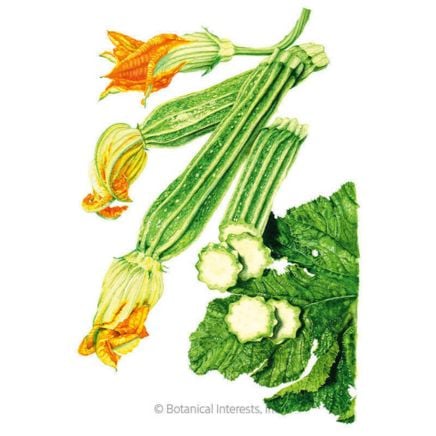
Costata Romanesco Summer Squash Seeds
Benefits of Growing Vertical Zucchini
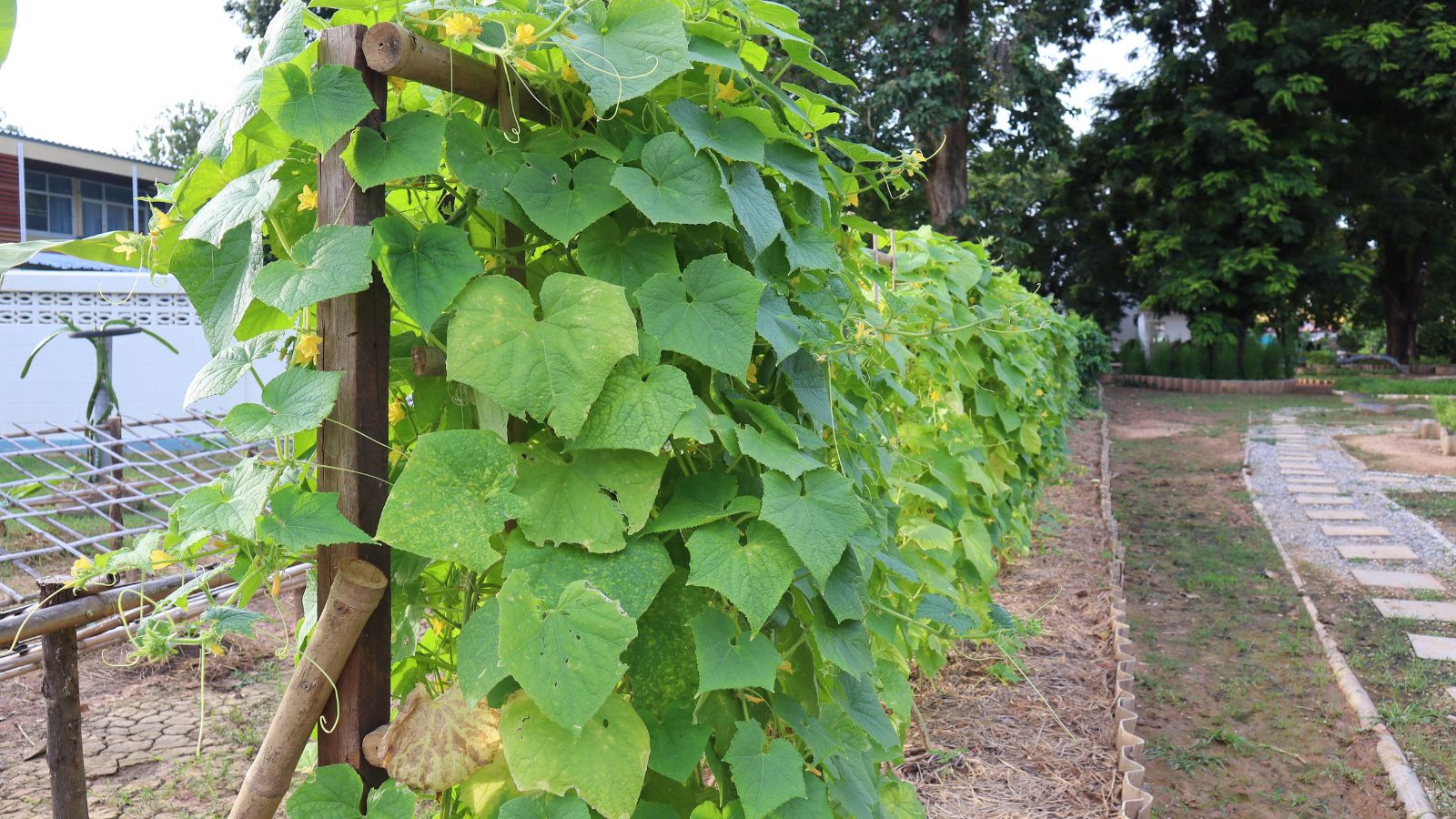 The main benefits are saving space, reducing disease, and saving time.
The main benefits are saving space, reducing disease, and saving time.One of the most rewarding benefits of growing zucchini vertically is seeing the pretty fruits develop as they shoot from the stem. Unencumbered, they form full, uniform, well-shaped cucurbits. Enjoy the easy harvest of blossoms and fruits in addition to:
- Saving space: Growing zucchini on a trellis makes them a fit for numerous garden situations, from small sites like balconies and patios to raised beds and large containers. It increases the surrounding bed space to allow for interplanting with companions and other crops.
- Lessening disease spread: Lifting the leaves, stems, and fruits improves overall health by increasing air circulation and limiting the spread of common fungal problems like powdery mildew. Conditions become less damp and crowded, with minimal irrigation splashing on leaves to spread the spores. There’s also a faster dry time after rains or watering sessions with improved airflow.
- Making pest and disease scouting easy: As members of the Cucurbitaceae family, summer squashes are susceptible to the same problems that impact winter squashes, melons, and cucumbers. The squash vine borer and squash bug are particularly challenging pests, which may be easier to detect on upright specimens. The insects are more visible with fewer hiding places, and damage is more obvious. Look for brown egg clusters on the undersides of leaves (squash bug) or singular eggs on stems (squash vine borer).
- Balancing sun exposure: Open-air leaves and stems benefit from all-over sunlight. Not only harnessing the rays for photosynthesis, the fruits need sun to develop healthy skins to protect their tender flesh.
- Saving money and time: With minimal materials, vertical zucchini saves space and reduces disease with simple materials. Use those you have on hand for staking, like bamboo, or purchase reusable supplies for seasons of growing. Once off and running, the time to support the stems is minimal compared to tending and treating for problems.
Know Your Type for the Best Support
 Vining types are best for this method.
Vining types are best for this method.Zucchini is available mainly as bush types, but also includes vining selections. Bushing varieties are compact, easy to manage, and a fit for smaller vertical growing structures. Vining types grow longer and even climb, depending on the variety, as they grow all season with high yields.
As more compact plants, bushing varieties take less time to mature than many vining squashes. They’re strong options for easy training, small spaces, and in climates with short growing seasons. They also make good successional plantings for another round of harvesting. A benefit of a late-season round is that it avoids the most active pest cycle of June to mid-July.
Determine if you’re growing a vining or bush variety to plan for upright support. When scaling your trellis, make sure it’s the right size for mature vines. Longer vines benefit from a larger support.
Install the support structure at planting to train vines as they grow and to give tendrils a clasping point. If you missed installing at planting, convert existing crops by carefully inserting the support structure and tying off existing vines.
Use the Single Stake Method for Bush Types
Bushing zucchini grows upright with the support of a simple stake or pole. The low-cost method boosts vigor and production and makes for easy tending and harvesting.
Materials
 A staking pole can be used as a central support.
A staking pole can be used as a central support.Craft a central support with supplies around the house or with a reusable purchase. The staking pole can be an electrical conduit, thick bamboo, a wooden post, or other upright material. The stake should be about three feet tall above the ground, with six or more inches in the ground for stability.
Use a mallet or hammer to tamp the stake into the soil. Keep jute twine handy so you can use it to tie stems throughout the season.
Install and Plant
 Make sure the stake is hammered in near the center of the plant at the time of transplanting.
Make sure the stake is hammered in near the center of the plant at the time of transplanting.Hammer the stake into the soil until it feels sturdy and immovable. While the bushy cucurbits won’t need great height, they will need a sturdy post to support their weighty yields all summer.
Loosen the roots of the transplant and situate it next to the stake, planting within a few inches. Bury the seedling up to the seed leaf, just above the crown, and slightly deeper than the soil level of the pot. Add a layer of mulch to cover the root space, but keep it off the tender stems.
Tie Off Stems
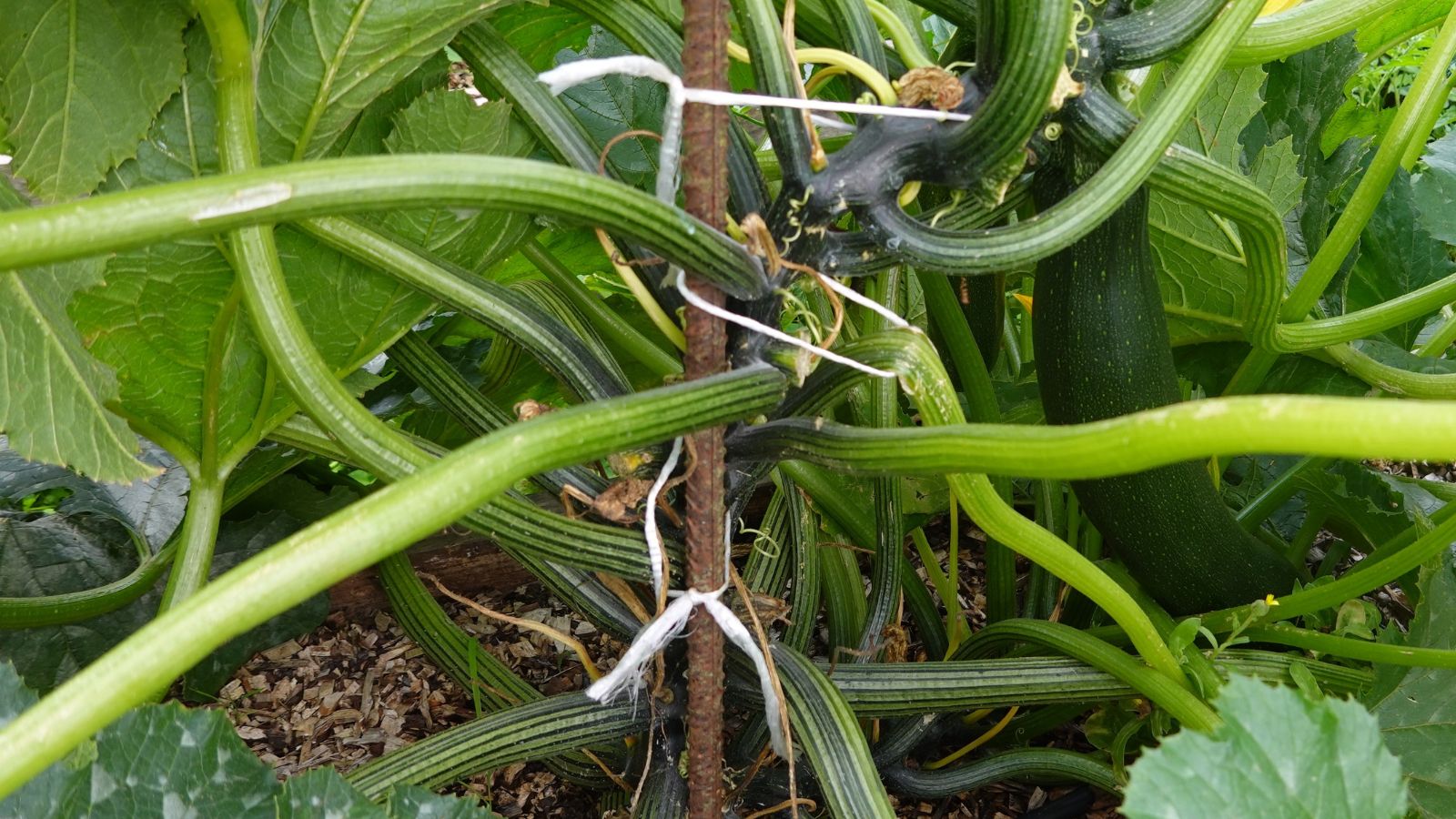 Use twine to help the stem attach to the trellis, but don’t tie too tight.
Use twine to help the stem attach to the trellis, but don’t tie too tight.The stem is ready for tying when the zucchini puts on six to eight inches of vertical growth. They may still seem self-supporting at this point, but getting the stem in place is helpful before the vertical growth point takes off quickly. At this stage of initial cinching, the plants will already show large leaves, flowers, and early fruits.
Use a piece of twine to tie the stem to the stake and allow for a little slack. Take care not to disrupt the blossoms or developing fruits. Tie off vines as they grow at about every four inches.
Cut Off Lower Leaves
 Pruning lower leaves increases airflows and directs energy upward.
Pruning lower leaves increases airflows and directs energy upward.With warm weather, zucchini hits its growing stride after a few weeks. As the stalk grows, remove lower leaves by clipping them close to the stem. There are multiple benefits to this simple pruning, mainly that it directs energy upward to the fruits and upper leaves. Removing lower leaves also lifts them from the ground and improves airflow to reduce disease. It also thins the stems for added space around the trunk.
The thick primary stem will look oddly bare, but it makes for a healthy summer squash.
Convert Existing Plants
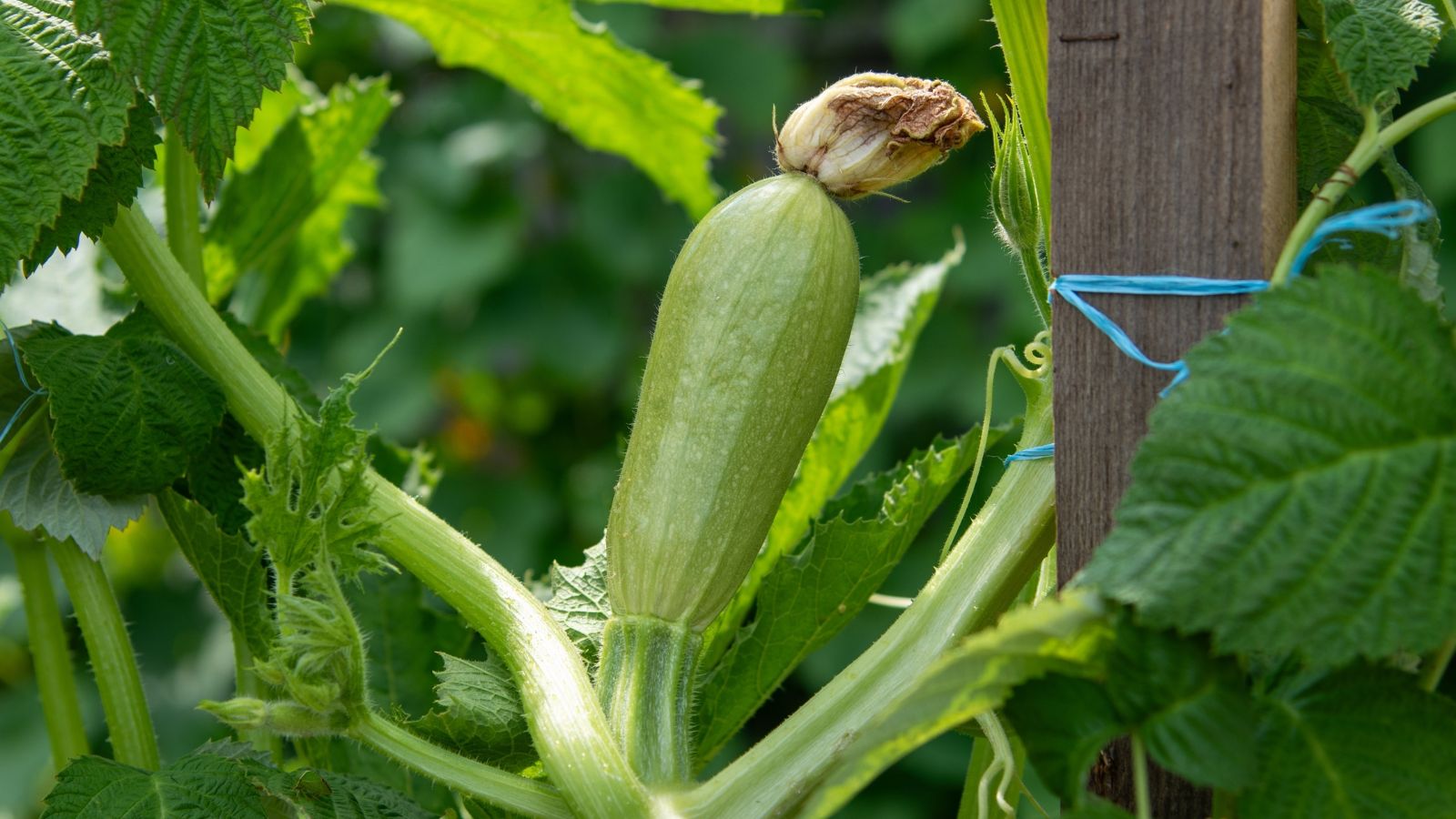 The primary stem should remain flexible so it can continue trellising along the stake.
The primary stem should remain flexible so it can continue trellising along the stake.If you’re looking to transition your current cucurbits to upright supports, begin by cutting off any leaves with signs of disease. Insert the anchor stake next to the primary stem. The stem is pliable with flexibility for easy training without damage.
Tie the upper portion of the plant to the post first to prevent it from flopping over. Then, work downward to tie the remainder of the stalk in segments. The disturbed growth may look stressed initially, but will quickly orient toward the sun in its new vertical position.
Go Larger With a Trellis
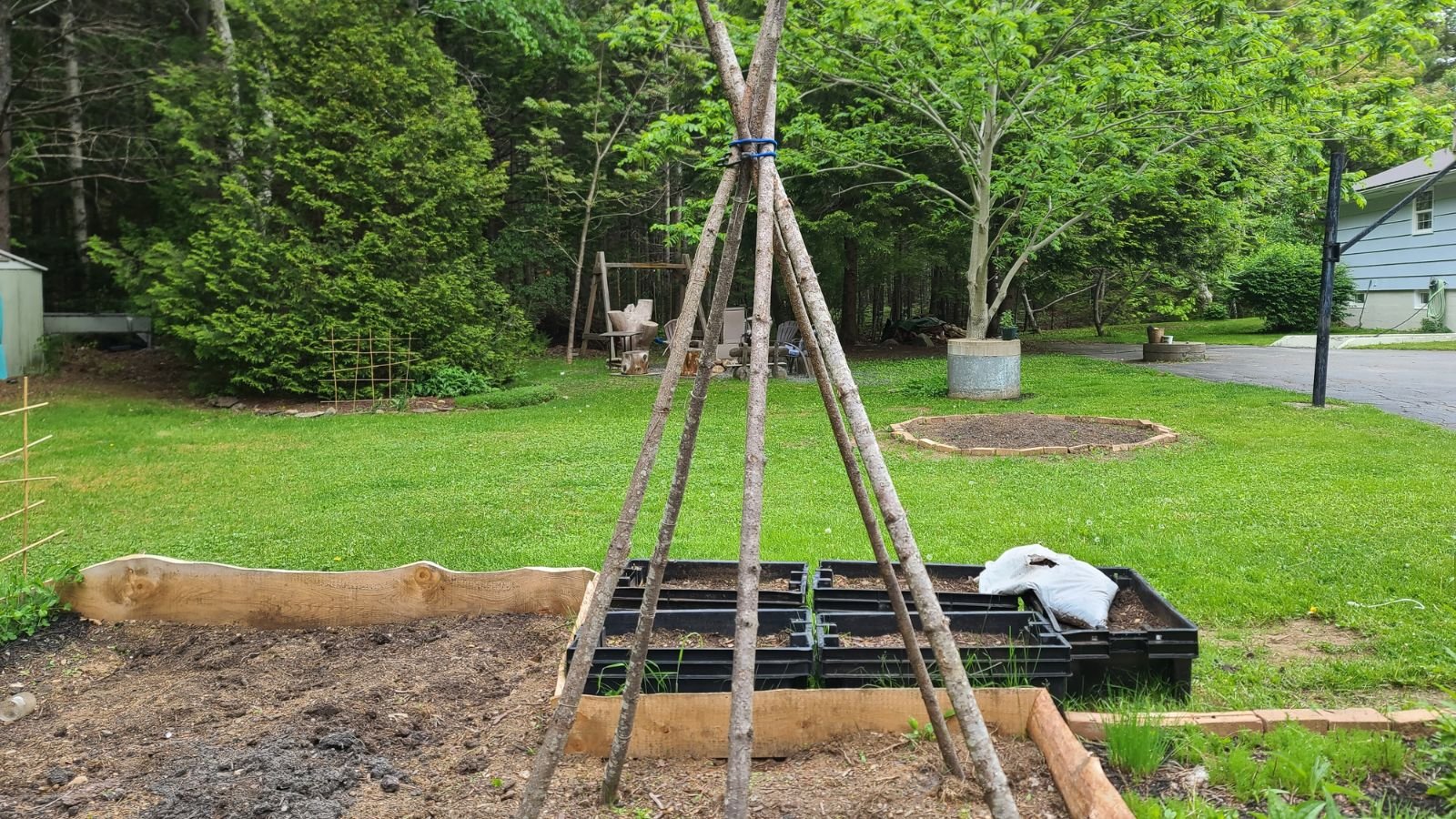 Sturdy materials are key to prevent toppling.
Sturdy materials are key to prevent toppling.Trellises work for growing all types of vertical zucchini, as long as they offer enough height and width to hold mature vines. Bush types can use small, four to five-foot-tall and wide trellises. Longer squashes will need more room to run. Tie off the stems every several inches as they grow, to direct growth, just as in the single-stake method.
Use sturdy materials to support the weight of stems and fruits. A squash trellis may be a series of gridded string, wire, or poles, an arbor, or lattice work. A heavy-duty version of a tomato trellis works well.
An easy form is to anchor two wooden or metal stakes in the ground and run lines of twine or wire between them. Space the horizontal lines at four to six-inch intervals. You can also run lines vertically to an upper cross post for upright efficiency. The lines become the climbing attachment points for tying off stems and clasping tendrils.
In placing the trellis, observe the sun’s movement. Consider sun exposure for the cucurbits and the surrounding crops that the trellis may shade. Trellised vines are dual-purpose when strategically placing crops that prefer afternoon shade in their shadow. A southern or western placement shields nearby crops from mid to late-day sun. Place tall structures at the north end cap to avoid shading out others.
Explore Other Vertical Options
Growing the curcubits on supports allows total creativity. A deck railing or fence becomes a growing space. Sturdy trellises along a wall or in the ground, raised beds, and pots add high visual interest in addition to growth benefits.
A-Frame
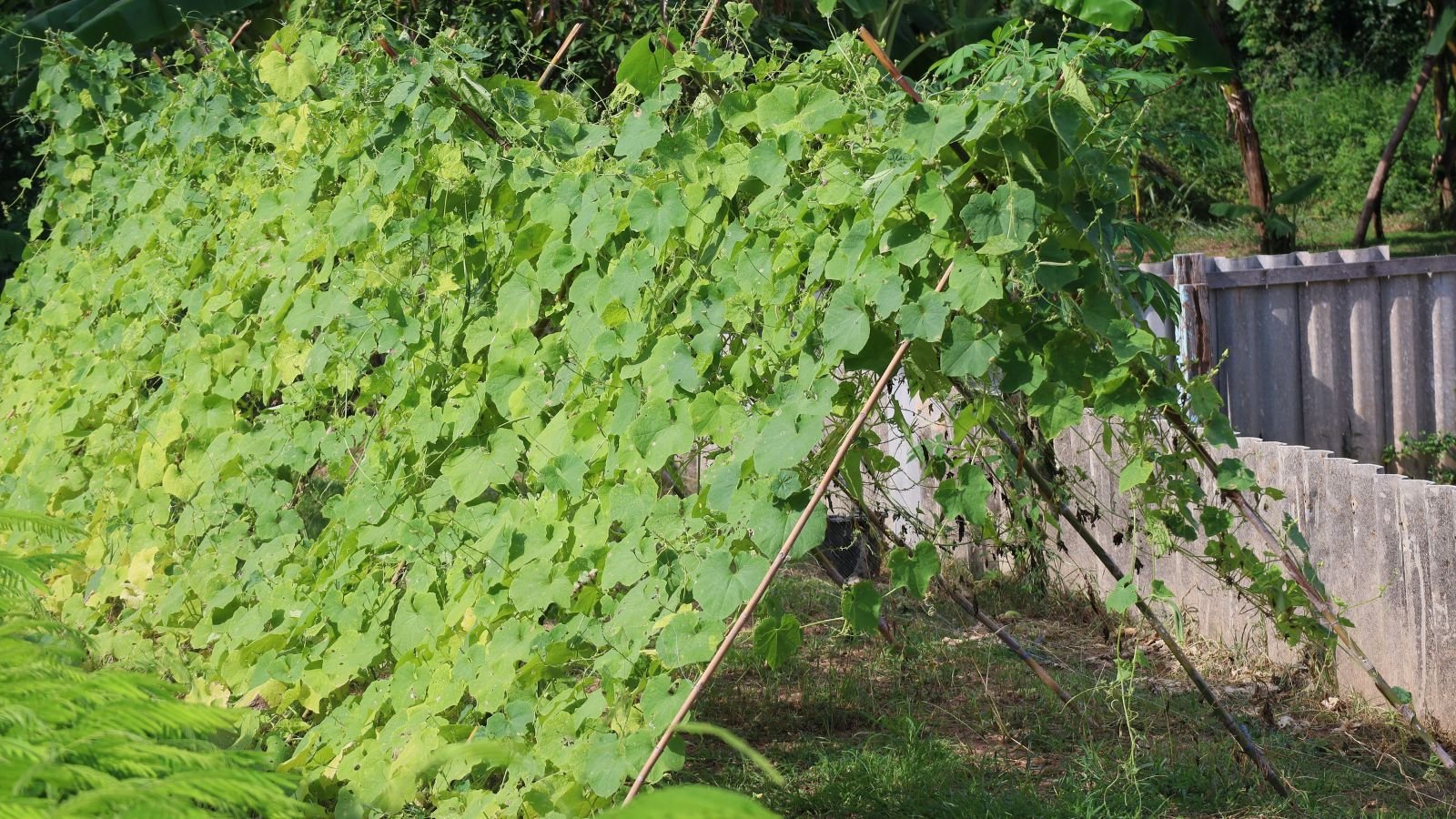 This style allows vines to run up or down the frame.
This style allows vines to run up or down the frame.A-frames are a folding trellis with two panels that meet at the top to form an open triangle. Make your own with gridded wire or cattle fencing panels, wooden latticing, or other streamlined materials with horizontal and vertical supports. The structure should be four feet tall or more at its peak to accommodate vine length. Let the vines run up and down the frame. Or, choose a bush or semi-bush variety and plant one on each side of the frame.
Panel
 An upward panel creates a wall or fence line of vines.
An upward panel creates a wall or fence line of vines.Upright frames like panels allow verticality in row systems, beds, and along walls and fences. Cattle fencing and wire-gauge panels are ready-made options to anchor to a wall or an in-ground frame.
Configure panels to the length and height of your summer squashes. Size varies, but three to four feet wide and four to five feet tall usually accommodate the crops. If growing the leafy vines near a wall or fence, allow spacing between the support structure for ample airflow.
Arch
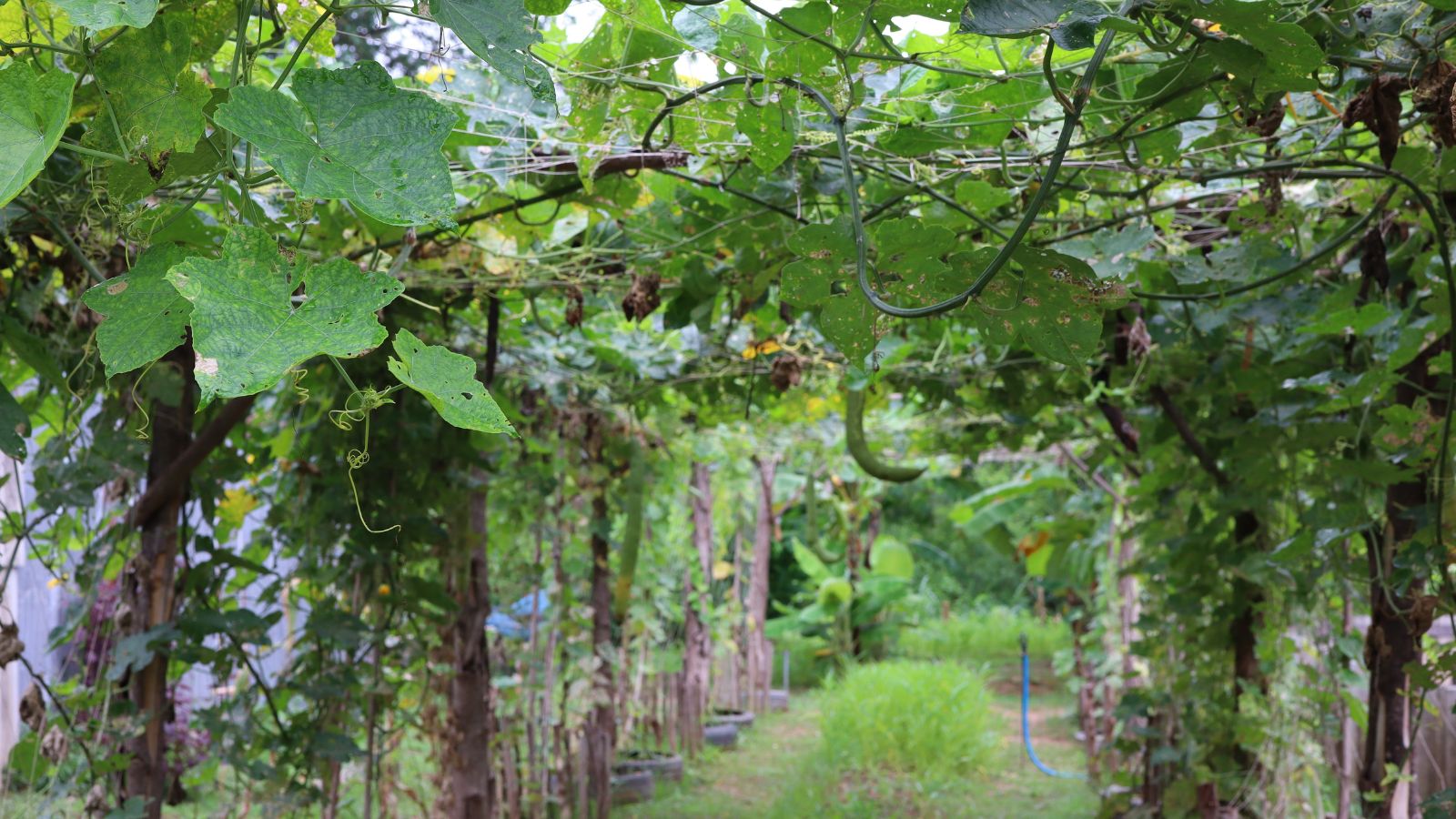 The archway makes it fun and beautiful to grow zucchini vertically.
The archway makes it fun and beautiful to grow zucchini vertically.An arch or tunnel is a fun way to grow the fruits and to enjoy seeing them develop. Frame a walkway, or bridge planter boxes and beds. Like trellises, arches shade underplantings, which is helpful for some crops during the midday sun or those that prefer partial shade. A DIY arch employs pliable materials like wire panels and fencing. Fruits hang as they develop for better form and added interest.
Short-vined zucchini won’t carry the arch in terms of overage. Pair them with other squashes and vining crops like baans for a complementary partnership. Flowering vines, too, add diversity.
Tripod
 These easy trellises can be made of bamboo or sturdy branches.
These easy trellises can be made of bamboo or sturdy branches.Tripods offer structural interest with their upright growing function. Use strong posts tied, secured, or forged at the pinnacle. Posts can be sturdy bamboo or felled branches cut to size.
Tie lateral supports every four to six inches around the poles. The zucchini grows up the three arms of the structure and on lateral supports.
Practice Companion Planting
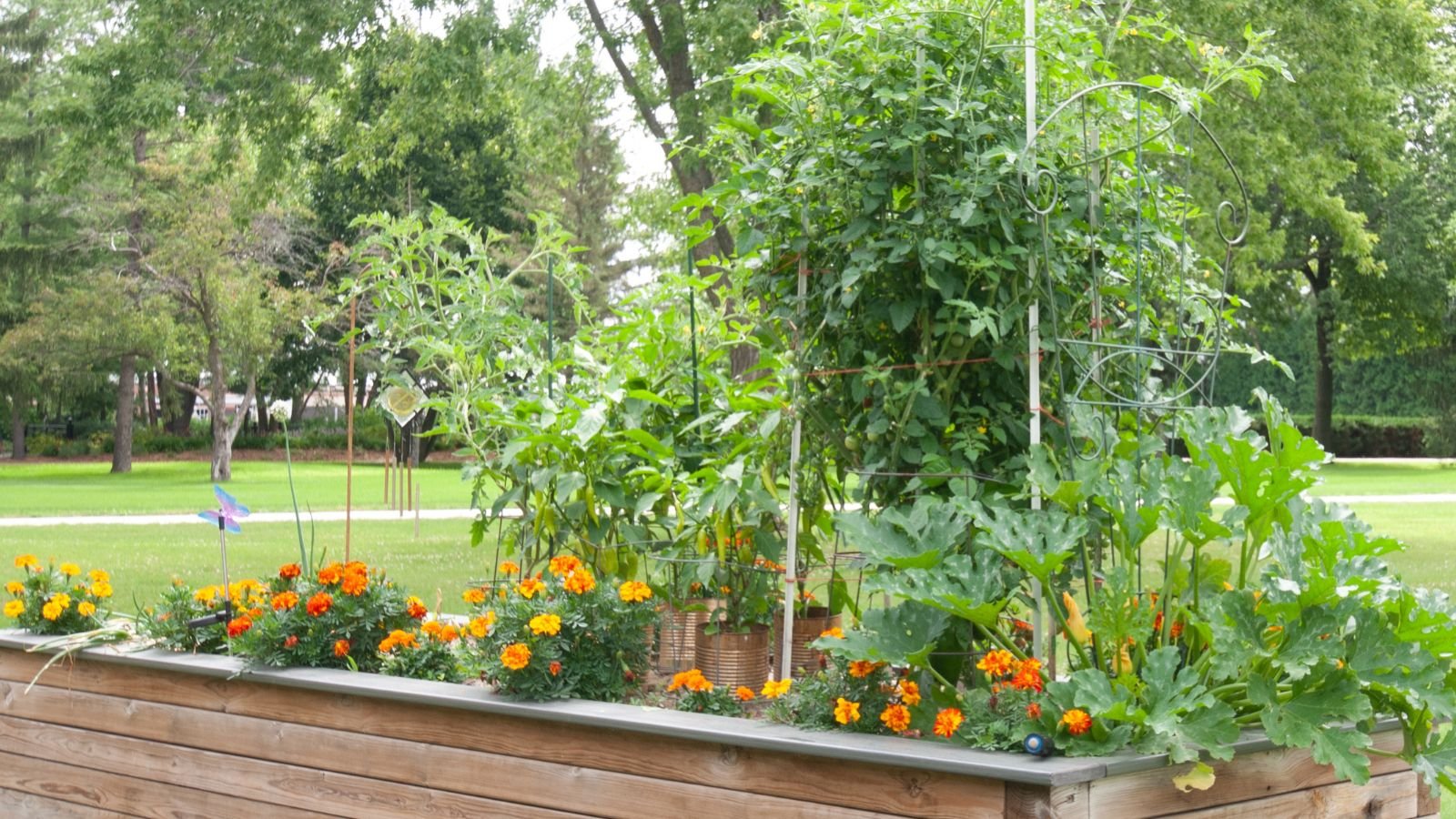 Grow companion plants along the base of the trellis for enhanced pest control.
Grow companion plants along the base of the trellis for enhanced pest control.With all the extra space gained in going vertical, we’ll have room to plant beneficial partners. Companions serve to benefit one or both of the plants. They may deter pests or attract beneficial ones, provide cooling shade, improve soils, and even enhance flavor. They require the same growing conditions and don’t compete for resources.
Companion plants for zucchini include those with essential oils to help prevent pests like squash bugs. Nasturtiums and marigolds offer pest-deterring qualities, as do perennials like beebalm and catmint. Interplant the blooms with the cucurbits or in the vicinity.
Flowering plants attract pollinators and increase biodiversity. Zucchini’s male and female tubular blooms rely on pollination from bees to set fruit. Bees shimmy into the blossom for pollen and nectar, and large granules stick to their fuzzy bodies. They transfer the grains from male to female blooms as they travel.
But the cucurbits have tenuous pollination – they require frequent bee visits per bloom. In areas where activity is low, so might fruiting be. With blooming selections nearby, squash blossoms will have plenty of beneficial insect visits with less need for hand-pollinating.
Vertical Zucchini Varieties
Many compact zucchini varieties, including favorite heirlooms, are a fit for smaller spaces and shorter trellises or stakes. For climbing types, look to larger supports.
‘Emerald Delight’
 It is known for compact growth and high yields of dark, shiny fruits.
It is known for compact growth and high yields of dark, shiny fruits.‘Emerald Delight’ is a compact hybrid with full-sized fruits and flavor. The high-yielding, bushy plants produce loads of tender zucchini. Stems grow three to four feet wide with an open, bushy form.
Harvest the green zukes at their peak of six to eight inches long (they grow longer if left on the vine). Skins will be dark and shiny, and the interior creamy. The airy habit makes the ready fruits easy to see and pick.
‘Emerald Delight’ is fast-maturing, ready in only 50-55 days, and ideal for areas with short growing seasons or late-season plantings. It’s disease-resistant against powdery mildew and mosaic viruses.
‘Black Beauty’
 These blackish-green fruits have tender flesh.
These blackish-green fruits have tender flesh.This favorite 1920s introduction offers vigorous production of dark, greenish-black fruits that have thin skins and tender, creamy interiors. ‘Black Beauty’ is an All-America Selections award winner for its prolific, early, and flavorful fruits on an easy-to-grow form.
Look to harvest near 50 to 55 days after sowing. Pick ‘Black Beauty’ young for the best texture and flavor.
‘Incredible Escalator’
 This climbing type is perfect for growing upward.
This climbing type is perfect for growing upward.‘Incredible Escalator’ brings novelty as a climbing zucchini. Ready for vertical growth up a trellis, arch, or fence, the climber produces rich green fruits ready for easy access come harvest time.
The uniform fruits of ‘Escalator’ are tender with a nutty flavor. Harvest them at six to eight inches or earlier for peak ripeness.
‘Tromboncino’
 This elongated squash adds practical and aesthetic benefits.
This elongated squash adds practical and aesthetic benefits.‘Tromboncino,’ also called ‘Zucchino Rampicante,’ is botanically a winter squash. But it makes the trellis list for good reasons: it’s delicious harvested young as a zucchini stand-in, it resists squash vine borer, and it develops amazingly long, curled fruits.
The Italian heirloom with long fruits matures in the fall but is prime for earlier summer picking. They ‘Zucchino’ add vertical interest as they grow to reach a curvy three feet long. A trellis or arch puts the vines and squash on display.
‘Tromboncino’ is tasty and tender when young and green, developing butternut characteristics later if left on the vine. As a disease- and squash vine borer-resistant C. moschata, ‘Tromboncino’ is a good one to try in place of summer squashes where pests and diseases are a problem.
Frequently Asked Questions
Several companions enjoy a little cooling shade and protection from the intense summer sun. Lettuce, collard greens, garlic, and carrots benefit from partial shade while temperatures rise. Beans, tomatoes, and cucumbers tolerate afternoon sun protection. Many herbs do well in dappled conditions. For deeper shade, look to shade annuals and perennials to draw pollinators.
Many types of zucchini are bush types and grow well in pots that are five gallons or larger. Install a trellis or support at planting to train the stems upward as they develop. Make sure the containers are well-draining and use a quality potting mix for good aeration.


 1 month ago
16
1 month ago
16





















 English (US) ·
English (US) ·  French (CA) ·
French (CA) ·